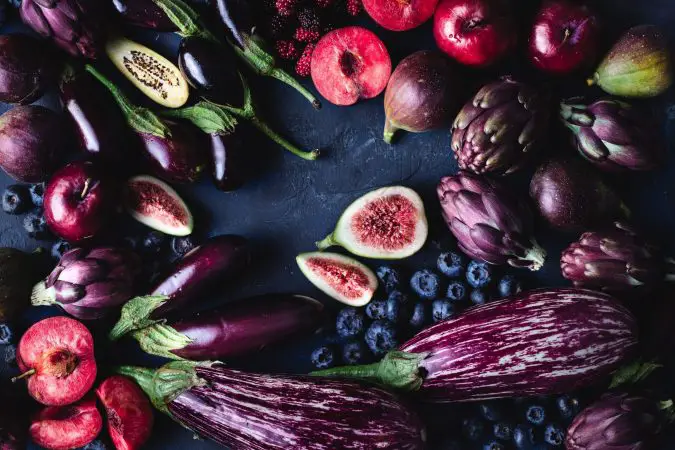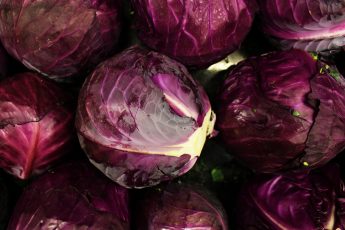The color of your foods can be indicative of how nutritious they are. That is why dieticians and nutritionists tell you to choose bright-colored fruits and vegetables if you want to reap the benefits.
You already know that bright orange and yellow fruits and vegetables have that color because of having high levels of beta-carotene, which is an antioxidant that is not only great for your eyesight but excellent for your skin and other tissues.
The same applies to purple foods. You know that purple fruits are high in a potent antioxidant known as anthocyanins, as that is what gives them the purple color.
Anthocyanins are essential for tissue repair, are good for your eyes, heart, and brain, help stave off certain cancers, and have so many other benefits.
So let’s go over the list of purple vegetables you should grab from the grocery store because of their fantastic health benefits.
Purple Vegetable Names
Purple Onion
Purple onions are also known as red onions, and they have plenty of powerful nutrients that you need to stay healthy. Not only do they provide extra flavor by not providing too many extra calories, but they can give your meals a nutritious boost too. Purple onions contain phytochemicals which is a plant chemical that is excellent for your health.
They have many Vitamin C, which is ideal for your immune system and helps with tissue repair. Additionally, purple onions contain manganese which is essential for having excellent bone health.
Not only are purple onions high in anthocyanins, but they also contain flavonoids and quercetin, which is good for your heart health. These antioxidants can help to reduce hypertension as well. Therefore, if you have high blood pressure, including purple onions in your diet is ideal.
Purple Cabbage
Purple cabbage is high in antioxidants, but it is rich in Vitamin C and K1, which are excellent for tissue repair, boosting the immune system and bone health. The vegetable is also high in fiber which helps to aid in weight loss and maintenance as the fiber controls appetite. This vegetable is cruciferous, similar to broccoli, cauliflower, kale, and Brussels sprouts.
Purple cabbage is similar to green cabbage other than the fact it is purple and thicker than green cabbage. It also has properties that help to stave off cancer and is good for depression as well. You can use purple cabbage as a replacement for green cabbage for aesthetic reasons too.
Purple Cauliflower
Cauliflower can be purple too, and it has even more benefits than white cauliflower because this vegetable is high in antioxidants and contains a variety of B-vitamins. In addition, purple cauliflower also contains Vitamins C, E, and K, as well as a variety of minerals. Therefore, you know that this vegetable is excellent for you.
At the same time, purple cauliflower has a sweet and nutty taste and is milder than its white counterpart. Therefore, you may prefer to eat it for a snack by using dip or salsa to flavor it, or you can cut it up and toss them into your salad which makes it pretty and tasty.
Purple Carrots
Carrots are not always orange and did not start as orange and edible back in the day. However, changes to the breeding of carrots changed that drastically, and carrots can be purple. Purple carrots have plenty of health benefits and are very high in anthocyanins, Vitamin K, and other minerals.
Not only are they excellent for your bone health, but they are great for your heart and eye health too, and they can help lower blood pressure. In addition, purple carrots contain a lot of fiber which can help with weight loss and maintenance.
These carrots can range from a red purple to deep violet and can be sweet and peppery in flavor. You can cook them, and you can find some great recipes that involve cooking purple carrots.
Purple Asparagus
If you don’t care for green asparagus because you find the taste too bitter, you can go for purple asparagus. That is because purple asparagus is sweeter and milder in flavor. You can already guess that purple asparagus has much higher levels of anthocyanins than their green counterparts, which means they have a much better effect on improving your cardiovascular health and lowering your blood pressure.
Additionally, these vegetables have so many other fantastic nutrients that are just so good for you. So why not give these vegetables a try, as you will notice how much sweeter and milder they are after cooking them.
Eggplant
 Eggplant may technically be a fruit, but it is still more acceptable to place it in the vegetable category. Therefore, eggplants are also high in antioxidants in addition to Vitamins A and C, and that means they are good for your immune system, cardiovascular health, and eye health.
Eggplant may technically be a fruit, but it is still more acceptable to place it in the vegetable category. Therefore, eggplants are also high in antioxidants in addition to Vitamins A and C, and that means they are good for your immune system, cardiovascular health, and eye health.
Additionally, the polyphenols in eggplant are good for your blood sugar levels when keeping them at an acceptable level. That is why those who have diabetes are encouraged to have some eggplant in their salads.
However, if you have arthritis, you may want to avoid eggplant as it contains a chemical known as solanine, and it can worsen inflammation. You will want to talk to your doctor about that.
Want to know everything there is to know about Vegetables and their types. CLICK HERE
Conclusion
There are other purple vegetables such as kale, Brussels sprouts, potatoes, and sweet potatoes. The one thing that all purple fruits and vegetables have in common is that they are high in antioxidant anthocyanins. Therefore, you will want to add more purple vegetables to your diet. In addition, most of them are sweeter than other vegetables that are the same type.
That means purple Brussel sprouts, for example, are sweeter in flavor than the green ones. Also, purple vegetables look pretty on your dinner plate and in your salad. So you can have some fun eating them, and at the same time, you are doing your body a great favor!
Learn more about gardening HERE.

